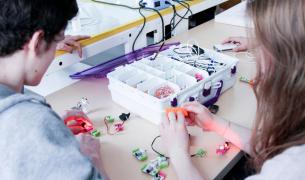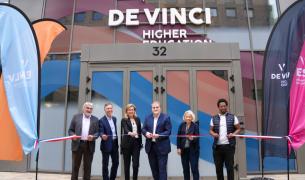L’Axe de recherche « Nouveaux Matériaux, Systèmes Intelligents et Entreprises innovantes » organise ses travaux autour de quatre sous-axes de recherche majeurs :
La recherche de matériaux intelligents fonctionnels représente un défi majeur dans de nombreux domaines tels que l’automobile, l’aéronautique et la biomédecine. Dans ce contexte, nos chercheurs collaborent en mettant en commun leur expertise pour concevoir des métamatériaux bio-inspirés architecturés et des smart matériaux, depuis la phase de conception numérique jusqu’à l’optimisation des propriétés structurales et/ou fonctionnelles, en passant par la fabrication et la caractérisation expérimentale. Les technologies développées réunissent des compétences dans plusieurs domaines, notamment la modélisation et simulation numérique multi-échelles, la simulation par éléments finis, l’Intelligence Artificielle, l’impression additive, le smart manufacturing et les méthodes expérimentales.
Dans le cadre de la transformation numérique, la sécurité digitale joue un rôle primordial. Au sein de l’Axe ce thème englobe la cybersécurité, la sécurité des réseaux, la résilience et la cryptographie, revêtant une importance significative avec une visibilité à la fois nationale et internationale. Le deuxième thème porte sur les systèmes intelligents, qui sont des composantes essentielles de la transformation numérique. La recherche au sein de l’Axe dans ce domaine se concentre sur les interactions entre l’humain et la machine, que ce soit du point de vue visuel, audio et/ou tactile, ainsi que sur la robotique, les objets connectés, l’IoT, la réalité virtuelle, et la e-santé, en lien avec les récentes avancées de l’intelligence artificielle.
La manière d’organiser l’innovation et l’impact des innovations sur nos vies sociales, comportementales et organisationnelles revêtent une importance cruciale tant sur le plan théorique que pratique. Nos membres excellent à l’échelle internationale dans la compréhension et l’exploration du développement de nouveaux produits et processus, ainsi que dans d’autres domaines tels que la gestion des innovations technologiques, l’encouragement du talent, l’optimisation de la chaîne d’approvisionnement, la gestion avancée des entrepôts et des opérations, la promotion de marques, et l’impact qu’ils apportent aux individus, aux groupes et aux pays grâce à ces innovations. Nous avons également acquis une expertise dans le financement, le recrutement et le développement d’entreprises innovantes (entrepreneuriat et création de nouvelles entreprises).
Nous sommes très intéressés par la recherche de stratégies qui favorisent, promeuvent et gèrent les innovations dans ce monde numérisé et hyper-connecté. Nos membres se consacrent à l’étude de la stratégie numérique et de la transformation numérique, les ethnographies des phénomènes numériques (par exemple, la ludification, la blockchain, la gestion algorithmique), la psychologie dans un contexte numérique (affects et émotions dans l’espace numérique), le marketing numérique, les interactions numériques et sociales (via les dispositifs portables, la robotique, l’apprentissage profond, les jeux, etc.), ainsi que par l’analyse des modèles économiques existants et de l’évolution des entreprises innovantes.
Parmi les projets interdisciplinaires, nous incluons :
L’équipe d’enseignants-chercheurs Nouveaux Matériaux, Systèmes Intelligents et Entreprises innovantes.
L’ensemble des travaux des enseignants-chercheurs Nouveaux Matériaux, Systèmes Intelligents et Entreprises innovantes.
Navazhylava, Kseniya
Experiences of self-care through Youtube yoga videos in times of crisis Divers
FNEGE Médias, 2024.
@misc{navazhylava_2830,
title = {Experiences of self-care through Youtube yoga videos in times of crisis},
author = {Kseniya Navazhylava},
url = {https://fnege-medias.fr/fnege-video/experiences-of-self-care-through-youtube-yoga-videos-in-times-of-crisis/},
year = {2024},
date = {2024-02-01},
howpublished = {FNEGE Médias},
note = {Drawing on the Foucauldian technologies of the self, this study explores how individuals re-envision practices of wellbeing outside of traditional organizational contexts during extreme events. Based on a thematic analysis of 7,234 comments posted on the Yoga with Adriene YouTube channel in 2020, this study unpacks a technologically mediated practice of self-care, which we conceptualize as somametamnemata. Our findings illustrate three entangled aspects of somametamnemata relating to yoga, a form of bodywork: Caring about self through practicing yoga online; caring about self and others through sharing about yoga in written comments; and caring about self and others through responding to shared verbalizations of yoga. By situating the potentiality of individual wellbeing within ill-being, we shift debates and discussions of ?corporate wellness? beyond organizational boundaries.},
keywords = {},
pubstate = {online},
tppubtype = {misc}
}
Magni, Domitilla; Papa, Armando; Scuotto, Veronica; Giudice, Manlio Del
Internationalized knowledge-intensive business service (KIBS) for servitization: a microfoundation perspective Article de journal
Dans: International Marketing Review, vol. 40, no. 4, p. 798-826, 2023.
@article{magni_2248,
title = {Internationalized knowledge-intensive business service (KIBS) for servitization: a microfoundation perspective},
author = {Domitilla Magni and Armando Papa and Veronica Scuotto and Manlio Del Giudice},
url = {https://www.emerald.com/insight/content/doi/10.1108/IMR-12-2021-0366/full/html},
year = {2023},
date = {2023-12-01},
journal = {International Marketing Review},
volume = {40},
number = {4},
pages = {798-826},
abstract = {Purpose
A paucity of studies has used a microfoundation lens to examine servitization processes in internationalized knowledge-intensive business service (KIBS) companies. The research aims to bridge this gap by considering knowledge sharing as a form of both codified knowledge and informal feedback knowledge; it also assesses whether the adoption of knowledge transfer and translation practices in a servitization process positively moderates the effect of knowledge transformation on knowledge sharing for internationalized KIBS companies.
Design/methodology/approach
By adopting a microfoundation lens, the research offers an empirical analysis to identify the relations between codified and tacit knowledge in servitization processes within internationalized KIBS companies. The study is based on 326 respondents from 30 KIBS companies. A multiple regression analysis was used for hypotheses testing.
Findings
The authors found significant relations among the use of electronic documents in the servitization process (formal codified knowledge), personal advice in servitization (informal feedback knowledge) and knowledge sharing in internationalized KIBS companies. Findings also support the indirect effect assumed in the hypothesis between knowledge transformation and knowledge sharing in internationalized KIBS companies, which is positively moderated by the adoption of cross-cultural knowledge practices in the servitization process.
Originality/value
To the best of the authors' knowledge, this research provides the first conceptual model of the use of a microfoundation lens to examine knowledge sharing in internationalized KIBS companies. The micro level features individual knowledge sharing in the servitization process, while the meso level focuses on knowledge transformation in KIBS companies and the adoption of knowledge transfer and translation practices in the servitization process.},
keywords = {},
pubstate = {published},
tppubtype = {article}
}
Shirinbayani, Mohammadali; Navideh, Abbasnezhad; Nikooharf, Mohammad Hossein; Benfriha, Khaled; Kallel, Achraf; Zouhaier, Jendli; Fitoussi, Joseph
Manufacturing Process Effect on the Mechanical Properties of Glass Fiber/Polypropylene Composite Under High Strain Rate Loading: Woven (W?GF?PP) and Compressed GF50?PP Article de journal
Dans: Applied Composite Materials, vol. 30, p. 1717-1736, 2023.
@article{shirinbayani_2367,
title = {Manufacturing Process Effect on the Mechanical Properties of Glass Fiber/Polypropylene Composite Under High Strain Rate Loading: Woven (W?GF?PP) and Compressed GF50?PP},
author = {Mohammadali Shirinbayani and Abbasnezhad Navideh and Mohammad Hossein Nikooharf and Khaled Benfriha and Achraf Kallel and Jendli Zouhaier and Joseph Fitoussi},
url = {https://link.springer.com/article/10.1007/s10443-023-10143-7},
year = {2023},
date = {2023-12-01},
journal = {Applied Composite Materials},
volume = {30},
pages = {1717-1736},
abstract = {Long glass fiber thermoplastic laminates have garnered significant attention for their potential use in designing structural parts across various sectors, including automotive, aerospace, and petroleum. The growing demand for lightweight and reliable materials in hydrogen vessel reservoirs, intended for future vehicles, necessitates understanding the fast dynamic behavior (crash) of these materials for effective structural design in such applications.
This study presents an optimized approach for experimentally characterizing the overall dynamic mechanical behavior of Twill woven glass fiber reinforced polypropylene (W-GF-PP) laminates. The methodology focuses on reporting the strain rate effect on the
material response while attempting to isolate the inherent inertial disturbances in the specimen attributed to the test system. Tensile tests have been conducted until the specimen's total failure for three specific relative orientations of fiber: 0°, 90°, and ± 45°. The tests
span a strain rate range from quasi-static (10-4 s?1) up to 2000 mm?s?1 (approximately 160 s?1, depending on the specimen's actual response). The material's behavior appears sensitive, particularly for the ± 45° fiber orientation. The study also examines the impact of
the manufacturing process type on the dynamic behavior of the reinforced polypropylene.},
keywords = {},
pubstate = {published},
tppubtype = {article}
}
Chu, Junfei; Su, Wang; Wu, Jie; Yuan, Zhe
DEA-based proportional-sharing fixed cost allocation considering bi-objective optimization Article de journal
Dans: Or Spectrum, vol. 45, p. 1333-1360, 2023.
@article{chu_2371,
title = {DEA-based proportional-sharing fixed cost allocation considering bi-objective optimization},
author = {Junfei Chu and Wang Su and Jie Wu and Zhe Yuan},
url = {https://link.springer.com/article/10.1007/s00291-023-00727-x},
year = {2023},
date = {2023-12-01},
journal = {Or Spectrum},
volume = {45},
pages = {1333-1360},
abstract = {This paper proposes a new proportional-sharing approach for fixed cost allocation (FCA) among a group of decision-making units (DMUs) based on data envelopment analysis (DEA). We first prove the proportional invariance in DEA-based FCA. Then, we show that the ?all-efficient? assumption in existing models usually leads to the use of unrealistic weights in efficiency analysis. To address this issue, we relax this assumption and adopt a weight constraint approach. Further, we illustrate that some DMUs would always be allocated with zero fixed cost if only the goal of efficiency maximizing is considered. Therefore, some weight constraints are added, and a new bi-objective model is proposed to allocate the fixed cost among the DMUs in order to simultaneously maximize the efficiencies of the DMUs and make the allocation as close as possible to the one generated according to the DMUs' operation sizes. A mono-objective nonlinear program, which can be solved using dichotomy and a linear program solver, is used to obtain a non-dominated or Pareto-optimal trade-off solution for the bi-objective model. With the use of our approach, neither unrealistic weights nor zero fixed cost appears in the result. Finally, the proposed approach is applied to a numerical example and a commercial bank case study.},
keywords = {},
pubstate = {published},
tppubtype = {article}
}
Aloosh, Mehdi; Aloosh, Arash
Economic sanctions and spread of infectious diseases Article de journal
Dans: Health Policy, vol. 138, p. 104921, 2023.
@article{aloosh_2479,
title = {Economic sanctions and spread of infectious diseases},
author = {Mehdi Aloosh and Arash Aloosh},
url = {https://www.sciencedirect.com/science/article/abs/pii/S0168851023002063},
year = {2023},
date = {2023-12-01},
journal = {Health Policy},
volume = {138},
pages = {104921},
abstract = {Economic sanctions can induce economic crises and compromise the determinants of health. In the literature, economic crises have been found to increase the risk of infectious disease outbreaks. Presumably, sanctions can increase the risk of infectious disease spreads, indirectly. However, non-economic factors can fuel the adverse impact of sanctions, including political consequences of sanctions and civil war. We performed a systematic literature review of articles in Embase, MEDLINE, Scopus, Web of Science, Cochrane Library, and the grey literature to assess empirically the impact of economic sanctions on the spread of infectious diseases within and beyond the borders of sanctioned countries. Our review did not identify any study meeting our inclusion criteria. Most of the studies did not control for major socio-political events, particularly armed conflicts in the sanctioned countries. This discovery underscores a notable gap in the examination of the impact of economic sanctions on the propagation of infectious diseases, presenting a threat to global health. Using the social-ecological model, we hypothesize how the economic crisis resulting from economic sanctions affects determinants of health, increases the risk of the spread of infectious diseases and hinders the response capacity of health systems.},
keywords = {},
pubstate = {published},
tppubtype = {article}
}
Vanaei, Saeedeh; Rastak, Mohammadali; Magri, Anouar El; Vanaei, Hamidreza; Kaddour, Raissi; Tcharkhtchi, Abbas
Orientation-Dependent Mechanical Behavior of 3D Printed Polylactic Acid Parts: An Experimental-Numerical Study Article de journal
Dans: Machines, vol. 11, no. 12, p. 1086, 2023.
@article{vanaei_2542,
title = {Orientation-Dependent Mechanical Behavior of 3D Printed Polylactic Acid Parts: An Experimental-Numerical Study},
author = {Saeedeh Vanaei and Mohammadali Rastak and Anouar El Magri and Hamidreza Vanaei and Raissi Kaddour and Abbas Tcharkhtchi},
url = {https://www.mdpi.com/2075-1702/11/12/1086},
year = {2023},
date = {2023-12-01},
journal = {Machines},
volume = {11},
number = {12},
pages = {1086},
abstract = {In Additive Manufacturing, wherein the construction of parts directly from 3D models is facilitated, a meticulous focus on enhancing the mechanical characteristics of these components becomes imperative. This study delves into the nuanced impact of the orientation of deposited layers on the mechanical properties of 3D printed Polylactic Acid (PLA) parts. Experimental testing, coupled with predictive modeling using Tsai-Hill and Tsai-Wu criteria, forms the crux of our investigation. The predicted ultimate strength from both criteria exhibits commendable agreement with the 3D printed specimens across a spectrum of orientation angles. Concurrently, Finite Element Simulations are meticulously executed to forecast mechanical behavior, taking into account the observed elasticity and plasticity in various orientations. Our observations reveal a significant augmentation in Young's modulus and ductility/elongation?40% and 70%, respectively?when transitioning from ? = 0° to ? = 90°. Furthermore, the ultimate strength experiences a notable increase, leading to varied failure modes contingent upon ?. These findings underscore the pivotal role played by the orientation of printed layers in shaping the anisotropic behavior of 3D printed PLA parts, thereby integrating key process variables for optimization objectives. This study contributes valuable insights for professionals in the engineering, design, and manufacturing domains who seek to harness the advantages of 3D printing technology while ensuring that the mechanical integrity of 3D printed parts aligns with their functional requisites. It emphasizes the critical consideration of orientation as a design parameter in the pursuit of optimization objectives.},
keywords = {},
pubstate = {published},
tppubtype = {article}
}
Khalloufi, Hamza; Zaifri, Mohamed; Kadri, Mohammed; Benlahbib, Abdessamad; Kaghat, Fatima Zahra; Azough, Ahmed
El-FnaVR: An Immersive Virtual Reality Representation of Jemaa El-Fna in Marrakech for Intangible Cultural Heritage Experiences Article de journal
Dans: Ieee Access, vol. 12, no. 2024, p. 9331-9349, 2023.
@article{khalloufi_2549,
title = {El-FnaVR: An Immersive Virtual Reality Representation of Jemaa El-Fna in Marrakech for Intangible Cultural Heritage Experiences},
author = {Hamza Khalloufi and Mohamed Zaifri and Mohammed Kadri and Abdessamad Benlahbib and Fatima Zahra Kaghat and Ahmed Azough},
url = {https://ieeexplore.ieee.org/document/10373850?source=authoralert},
year = {2023},
date = {2023-12-01},
journal = {Ieee Access},
volume = {12},
number = {2024},
pages = {9331-9349},
abstract = {Intangible cultural heritage, a vital part of our collective human legacy, faces the threat of being lost in the tide of modernization. Preserving and promoting these cultural treasures require innovative approaches that transcend traditional boundaries. In this paper, we introduce "El-FnaVR", a groundbreaking virtual reality (VR) application that captures the vibrant essence of Marrakech's renowned UNESCO-listed Jemaa El-Fna square, Morocco. El-FnaVR immerses users in a detailed virtual replica of the square, replete with lifelike animated characters and spatial 3D audio that reproduces the locale's unique atmosphere faithfully capturing the location's distinctive ambiance. This paper delves into the comprehensive five-stage design and development process of the application, highlighting its unique features and demonstrating how it replicates the diverse activities and performances at the square. A user study, conducted with participants, reveals overwhelmingly positive responses, as participants laud the application's immersive nature, ease of use, and social appeal. The study's findings indicate that El-FnaVR successfully evokes the sensation of being present at the Jemaa El-Fna square, and offers valuable insights into the events and traditions that define it. As a significant step towards the preservation and promotion of intangible cultural heritage.},
keywords = {},
pubstate = {published},
tppubtype = {article}
}
Pelet, Jean-Éric; Taieb, Basma; Alkhudary, Rami
Measuring consumer perceptions of home-delivery convenience - the case of cargo bikes Article de journal
Dans: International Journal Of Retail & Distribution Management, vol. 51, no. 9, p. 1371-1387, 2023.
@article{pelet_2323,
title = {Measuring consumer perceptions of home-delivery convenience - the case of cargo bikes},
author = {Jean-Éric Pelet and Basma Taieb and Rami Alkhudary},
url = {https://www.emerald.com/insight/0959-0552.htm},
year = {2023},
date = {2023-11-01},
journal = {International Journal Of Retail & Distribution Management},
volume = {51},
number = {9},
pages = {1371-1387},
abstract = {Purpose - Despite the increasing use of home delivery (HD) in e-commerce, no studies have explicitly
examined consumer perceptions of the convenience of the last-mile delivery of goods by cargo bike (CB).
Therefore, this study aims to identify the dimensions of HD convenience and to develop a reliable and valid
measurement tool, namely the Home-Delivery Convenience via Cargo Bike (HDCCB) scale.
Design/methodology/approach - The methodology of this scale development study is premised on a
review of the existing literature, which identifies differences in consumer perceptions of the convenience of
services. The authors conducted semi-structured interviews with 10 online consumers and validated the
content with 3 experts on marketing in the retail and services sectors in order to develop the items for the scale.
Thereafter, the authors identified the main dimensions through an exploratory factor analysis that the authors
applied to an online survey with 116 respondents. Finally, the scale was validated through a confirmatory
factor analysis of an online survey with 300 respondents.
Findings - Following the original work of Brown (1990), the authors define consumer perceptions of HD
convenience as a multidimensional construct and measure each facet of its four dimensions, which are time, use,
execution and acquisition. E-retailers and last-mile logistics providers could use the authors' proposed
measurement tool to assess consumer perceptions of the convenience of HD. That assessment could generate a
competitive advantage.
Originality/value - This study is original as the study deepens the existing understanding of consumer
perceptions of the convenience of HD by CB in last-mile logistics. This study also develops a multidimensional
measure that is based on an empirical study.},
keywords = {},
pubstate = {published},
tppubtype = {article}
}
Wang, Mingzhe; Huang, Hai; Xiong, Jie; Yuan, Zhe; Zeng, Keya
Impact of ecological reserves on the local residents' health: Evidence from a natural experiment in China Article de journal
Dans: Social Science & Medicine, vol. 336, p. 116186, 2023.
@article{wang_2389,
title = {Impact of ecological reserves on the local residents' health: Evidence from a natural experiment in China},
author = {Mingzhe Wang and Hai Huang and Jie Xiong and Zhe Yuan and Keya Zeng},
url = {https://www.sciencedirect.com/science/article/pii/S0277953623005439?via%3Dihub},
year = {2023},
date = {2023-11-01},
journal = {Social Science & Medicine},
volume = {336},
pages = {116186},
abstract = {The potential influence of natural ecosystems on human health has been widely acknowledged globally. Nevertheless, the causality of such a correlation among the middle-aged and older populations in developing countries awaits further investigations. This study aims to understand how a specific natural ecosystem change, namely the establishment of ecological reserves, improves the physical and mental health of middle-aged and older residents in China. Two batches of national key eco-function zones (NKEFZs) in 2011 and 2016 are selected as a quasi-experiment; and a total of 128,755 middle-aged and older residents from a combined data set from the China Family Panel Studies (CFPS) and China Health and Retirement Longitudinal Studies (CHARLS) from 2010 to 2020. A difference-in-differences method was used to identify the causal effects of the natural ecosystem improvement on human health outcomes. The results indicate significant and sustained improvements in the physical health of local middle-aged and elderly residents following the implementation of the NKEFZs policy. Notably, ecological reserves with a water conservation function and those in Karst area have the most salient effects on physical health. Furthermore, this study shows that the creation of ecological reserves improves the mental health of middle-aged and older residents, with the effect varying based on changes in physical health. This study provides new insights into the positive impact of natural ecosystem improvement on human health outcomes, in particular physical and mental health.},
keywords = {},
pubstate = {published},
tppubtype = {article}
}
Zaifri, Mohamed; Khalloufi, Hamza; Kaghat, Fatima Zahra; Benlahbib, Abdessamad; Azough, Ahmed; Zidani, Khalid Alaoui
Enhancing Tourist Experiences in Crowded Destinations through Mobile Augmented Reality: A Comparative Field Study Article de journal
Dans: International Journal of Interactive Mobile Technologies, vol. 17, no. 20, p. 92-113, 2023.
@article{zaifri_2475,
title = {Enhancing Tourist Experiences in Crowded Destinations through Mobile Augmented Reality: A Comparative Field Study},
author = {Mohamed Zaifri and Hamza Khalloufi and Fatima Zahra Kaghat and Abdessamad Benlahbib and Ahmed Azough and Khalid Alaoui Zidani},
url = {https://online-journals.org/index.php/i-jim/article/view/42273},
year = {2023},
date = {2023-11-01},
journal = {International Journal of Interactive Mobile Technologies},
volume = {17},
number = {20},
pages = {92-113},
abstract = {Mobile augmented reality (MAR) has gained significant attention in the tourism sector as a way to enhance the visitor experience. The rapid advancements in mobile computing and sensor technologies have facilitated the widespread use of geospatial augmented reality (AR) applications by tourists when exploring popular destinations. To analyze the impact of AR technology on the tourism experience, we developed the FEZAR mobile application. This application serves as the focal point of our study, allowing us to evaluate user performance using a comparative experimental approach. To ensure the usability of the FEZAR application, professionals with expertise in mobile technologies, including AR, performed rigorous testing and evaluation of the application. Through their evaluations, significant usability issues were identified and resolved, resulting in the application being well-received by the experts. Subsequently, a comparative field study was conducted in Fez's old medina, a crowded UNESCO heritage site, involving users (N = 40) who were randomly assigned to experimental and control groups in equal distribution. The results of the study revealed that the proposed AR model had a significant positive impact on user visits. Compared to other forms of media, AR offers more informative and enjoyable experiences. Additionally, it effectively helps locate monuments in crowded tourism settings. The findings of this research make a valuable contribution to the ongoing discussion regarding the impact of evaluating MAR user interfaces on increasing visitor engagement with tourist destinations.},
keywords = {},
pubstate = {published},
tppubtype = {article}
}
Wang, Zhiqiang; Ezukwoke, Kenneth; Hoayek, Anis; Batton-Hubert, Mireille; Boucher, Xavier
Nature language processing (NLP) and association rules (AR)-based knowledge extraction for intelligent fault analysis: a case study in semiconductor industry Article de journal
Dans: Journal Of Intelligent Manufacturing, vol. 35, no. 9, p. 1-16, 2023.
@article{wang_2482,
title = {Nature language processing (NLP) and association rules (AR)-based knowledge extraction for intelligent fault analysis: a case study in semiconductor industry},
author = {Zhiqiang Wang and Kenneth Ezukwoke and Anis Hoayek and Mireille Batton-Hubert and Xavier Boucher},
url = {https://link.springer.com/article/10.1007/s10845-023-02245-7},
year = {2023},
date = {2023-11-01},
journal = {Journal Of Intelligent Manufacturing},
volume = {35},
number = {9},
pages = {1-16},
abstract = {Fault analysis (FA) is the process of collecting and analyzing data to determine the cause of a failure. It plays an important role in ensuring the quality in manufacturing process. Traditional FA techniques are time-consuming and labor-intensive, relying
heavily on human expertise and the availability of failure inspection equipment. In semiconductor industry, a large amount of FA reports are generated by experts to record the fault descriptions, fault analysis path and fault root causes. With the development of Artificial Intelligence, it is possible to automate the industrial FA process while extracting expert knowledge from the vast FA report data. The goal of this research is to develop a complete expert knowledge extraction pipeline for FA in semiconductor industry based on advanced Natural Language Processing and Machine Learning. Our research aims at automatically predicting the fault root cause based on the fault descriptions. First, the text data from the FA reports are transformed into numerical data using Sentence Transformer embedding. The numerical data are converted into latent spaces using Generalized-Controllable Variational AutoEncoder. Then, the latent spaces are classified by Gaussian Mixture Model. Finally, Association Rules are applied to establish the relationship between the labels in the latent space of the fault descriptions and that of the fault root cause. The proposed algorithm has been evaluated with real data of semiconductor industry collected
over three years. The average correctness of the predicted label achieves 97.8%. The method can effectively reduce the time of failure identification and the cost during the inspection stage.},
keywords = {},
pubstate = {published},
tppubtype = {article}
}
Cheyne, Max Troizier; Lebon, Nicolas; Laverne, Floriane
Impact of Intraoral Scanner Sleeves on STL File Accuracy: A Metrological Approach Article de journal
Dans: Computer-Aided Design and Applications (CAD&A), vol. 21, no. 4, p. 567-580, 2023.
@article{troizier_cheyne_2485,
title = {Impact of Intraoral Scanner Sleeves on STL File Accuracy: A Metrological Approach},
author = {Max Troizier Cheyne and Nicolas Lebon and Floriane Laverne},
url = {https://www.cad-journal.net/files/vol_21/CAD_21(4)_2024_567-580.pdf},
year = {2023},
date = {2023-11-01},
journal = {Computer-Aided Design and Applications (CAD&A)},
volume = {21},
number = {4},
pages = {567-580},
abstract = {Intraoral scanners (IOS) are essential tools in dental prosthodontics, enabling efficient digitization of dental arches for CAD-CAM workflows. The Primescan IOS (Dentsply Sirona) can be fitted with three scanning sleeves, based on the level of hygiene imposed by the clinical situation and health regulations: a standard sleeve (SS), an autoclavable sleeve (AS), and a disposable sleeve (DS). Most studies evaluating accuracy use local best-fit algorithms to superimpose a reference scan and a test scan, providing relative accuracy. This study proposes an alternative evaluation method based on metrological principles and aims to compare the quality of scans taken with the three types of sleeves. An 8 mm aluminum oxide sphere was scanned 24 times using each sleeve. Mesh analysis was conducted, and measures of trueness, precision, and digitizing noise were calculated. Significant differences in trueness were identified between AS-DS (p < 0.001) as well as AS-SS (p < 0.001), while no significant differences were found between the sleeves for precision (p = 0.623). Significant differences in digitizing noise were also identified between DS-AS (p < 0.001), DS-SS (p = 0.001), and SS-AS (p = 0.001). This study tested the scanning quality of an IOS fitted with different sleeves using absolute measures as opposed to relative measures, and though statistically significant differences were found, within the experimental conditions, the errors appear to be within clinically accepted limits.},
keywords = {},
pubstate = {published},
tppubtype = {article}
}
Vanaei, Hamidreza; Khelladi, Sofiane; Dobrev, Ivan; Bakir, Farid; Himeur, Rania M.; Mammeri, Amrid; Azzouz, Kamel
Performance and Efficiency of Cross-Flow Fans - A Review Article de journal
Dans: Energies, vol. 16, no. 23, p. 7798, 2023.
@article{vanaei_2539,
title = {Performance and Efficiency of Cross-Flow Fans - A Review},
author = {Hamidreza Vanaei and Sofiane Khelladi and Ivan Dobrev and Farid Bakir and Rania M. Himeur and Amrid Mammeri and Kamel Azzouz},
url = {https://www.mdpi.com/1996-1073/16/23/7798},
year = {2023},
date = {2023-11-01},
journal = {Energies},
volume = {16},
number = {23},
pages = {7798},
abstract = {Cross-Flow Fans (CFFs) have been widely applied in the automotive and domestic air conditioning industries in recent decades. They are high-pressure coefficient turbomachines compacted diametrically, and thus, the complex interactions of these fans require thorough evaluation. Their innovation has opened up new directions in turbomachinery, and both academic research and industry have seen numerous efforts to develop these types of fans. Despite extensive work, optimizing and improving their performance remains a challenge. Enhancing their efficiency necessitates improvements in structural characteristics, aerodynamic features, and acoustic properties. In this review, we aim to demonstrate the essential aspects of CFFs by introducing their fundamentals and primary characteristics. Furthermore, we delve into a discussion on the acoustic performance of these fans. We also summarize the flow characteristics and different flow-field patterns in CFFs and their impact on aeroacoustic behavior. The main objective of this review paper is to provide an overview of the research in this field, summarizing the critical factors that play a significant role in studying CFFs' performance.},
keywords = {},
pubstate = {published},
tppubtype = {article}
}
Khadimallah, Aymen; Petit, Johann; Hfaiedh, Naila; Znaidi, Amna
Characterization of fatigue behavior of AA2024-T351 aluminum alloy Article de journal
Dans: Fatigue & Fracture Of Engineering Materials & Structures, vol. 46, no. 10, p. 3543-4072, 2023.
@article{khadimallah_2380,
title = {Characterization of fatigue behavior of AA2024-T351 aluminum alloy},
author = {Aymen Khadimallah and Johann Petit and Naila Hfaiedh and Amna Znaidi},
url = {https://onlinelibrary.wiley.com/share/author/5HS4PJKGQVKNQNGDT9QT?target=10.1111/ffe.14102},
year = {2023},
date = {2023-10-01},
journal = {Fatigue & Fracture Of Engineering Materials & Structures},
volume = {46},
number = {10},
pages = {3543-4072},
abstract = {The paper aims to investigate the fatigue behavior of the widely used
AA2024-T351 aluminum alloy in the aircraft industry. An experimental program
was conducted to study the fatigue life and damage behavior under symmetrical
tensile-compressive loading. Cyclic tests in the low cycle fatigue
regime were performed under fully reversed total strain amplitudes from 0.6%
to 1.2%. The AA2024-T351 alloy exhibited cyclic hardening until failure. Symmetric
high cycle fatigue tests were also performed and the parameters for
fatigue life estimation using the Manson-Coffin-Basquin model were identified.
Elasto-plastic behavior was analyzed through stress-strain hysteresis
loops, evaluating kinematic and isotropic hardenings. Kinematic hardening
was found to be strain amplitude dependent, unlike the isotropic hardening.
The evolution of the isotropic variable with the percentage of fatigue life could
be described by an exponential law. Fractography investigations showed crack
initiation at the specimen border with quasi-cleavage and then crack propagating
by striation before ductile fracture.},
keywords = {},
pubstate = {published},
tppubtype = {article}
}
Islam, Gazi; Pillet, Jean-Charles; Navazhylava, Kseniya; Barros, Marcos
High-performance connections: Digital holism and communicative capitalism at HappyAppy Article de journal
Dans: Organization, vol. 30, no. 5, p. 1046-1073, 2023.
@article{islam_1769,
title = {High-performance connections: Digital holism and communicative capitalism at HappyAppy},
author = {Gazi Islam and Jean-Charles Pillet and Kseniya Navazhylava and Marcos Barros},
url = {https://journals.sagepub.com/doi/full/10.1177/13505084211057260},
year = {2023},
date = {2023-09-01},
journal = {Organization},
volume = {30},
number = {5},
pages = {1046-1073},
abstract = {The current study examines the ways in which new age organizations use digital culture to promote ?holistic? visions of personal and social well-being. Concepts of holism are common in contemporary and new age management settings, but are largely undertheorized by organizational scholars; moreover, the relations between holism and techno-culture, increasingly recognized by digital sociologists, are largely missing from organizational scholarship. Using the lens of ?communicative capitalism,? we carry out a case study of ?HappyAppy,? a French techno-startup association concerned with well-being related applications, to understand how holistic ideas are deployed and shaped within this association. We find that that holism is marked, on the one hand, by ?autarkic? fantasies, involving subjective integration and immersion, and on the other, by ?relational? fantasies, involving interpersonal connection and participation. Moreover, each of these versions of holism is associated with distinct critical possibilities. We use these results to theorize the role of digital holism at the intersection of new age management and digital culture, outlining an agenda for future research.},
keywords = {},
pubstate = {published},
tppubtype = {article}
}
Huang, Yanting; Liang, Yuqing; Gong, Yeming; Yuan, Zhe
Role of trust-building in online recycling platforms Article de journal
Dans: International Journal Of Production Economics, vol. 263, p. 108962, 2023.
@article{huang_2352,
title = {Role of trust-building in online recycling platforms},
author = {Yanting Huang and Yuqing Liang and Yeming Gong and Zhe Yuan},
url = {https://www.sciencedirect.com/science/article/pii/S0925527323001949?via%3Dihub},
year = {2023},
date = {2023-09-01},
journal = {International Journal Of Production Economics},
volume = {263},
pages = {108962},
abstract = {Many studies have addressed the research questions in online platforms and the collection of waste electric and electronic equipment. However, they may ignore the effect of trust-building in the online platform and how trust affects the optimal strategy in the recycling platform. Consumers must consider the price and credibility in the product recycling process due to the differentiated prices for the same products set by different online platforms. This work studies the profit of recyclers and platforms with a degree of trust-building in the reverse logistics system considering the following scenarios: online recycling platform builds trust or not under centralized and decentralized models. The results show that trust-building can effectively make more revenue for the system of the online recycling platform with enhanced demand if the cost of the trust-building construction is relatively low, especially in the centralized model. The revenue-sharing contract is more profitable than the cost-sharing contract but fails to achieve optimization in the integrated setting. We find a new decision support tool for optimal strategies under different decision-making models. This work helps the recycling platform improve mechanism design and make optimal decisions considering trust-building.},
keywords = {},
pubstate = {published},
tppubtype = {article}
}
Xiong, Jie; Lu, Xu; Li, Qian; Yuan, Zhe; Chakraborty, Shubho
Doing good and/or avoiding bad: the ambidextrous view of managing corporate social activities Article de journal
Dans: Management International, vol. 27, no. 5, p. 25-36, 2023.
@article{xiong_2466,
title = {Doing good and/or avoiding bad: the ambidextrous view of managing corporate social activities},
author = {Jie Xiong and Xu Lu and Qian Li and Zhe Yuan and Shubho Chakraborty},
url = {https://reflexion.hec.ca/notice?id=516f6909-f1dd-4865-830a-e4f6f0e6b66d},
year = {2023},
date = {2023-09-01},
journal = {Management International},
volume = {27},
number = {5},
pages = {25-36},
abstract = {Our objective is to examine how firms manage corporate social activities across divergent orientations, either pro-CSR (corporate social responsibility) and/or anti-CSiR (corporate social irresponsibility) activities. We investigate two different approaches to managing corporate social activities, namely, balanced and combined, and study their potential impacts on corporate performance from an ambidextrous perspective. In addition, we examine the moderation effects of firm size and financial risk. We tested our hypothesis using a panel of 5,292 firms from KLD and COMPUSTAT between 1998 and 2015.},
keywords = {},
pubstate = {published},
tppubtype = {article}
}
Serru, Théo; Nguyen, Nga; Batteux, Michel; Rauzy, Antoine
Minimal Critical Sequences in Model-Based Safety and Security Analyses: Commonalities and Differences Article de journal
Dans: ACM Transactions on Cyber-Physical Systems, vol. 7, no. 3, p. 1-20, 2023.
@article{serru_2313,
title = {Minimal Critical Sequences in Model-Based Safety and Security Analyses: Commonalities and Differences},
author = {Théo Serru and Nga Nguyen and Michel Batteux and Antoine Rauzy},
url = {https://dl.acm.org/doi/10.1145/3593811},
year = {2023},
date = {2023-07-01},
journal = {ACM Transactions on Cyber-Physical Systems},
volume = {7},
number = {3},
pages = {1-20},
abstract = {Discrete event systems are increasingly used as a modeling tool to assess safety and cybersecurity of complex systems. In both cases, the analysis relies on the extraction of critical sequences. This approach proves to be very powerful. It suffers however from the combinatorial explosion of the number of sequences to look at. To push the limits of what is feasible with reasonable computational resources, extraction algorithms use cutoffs and minimality criteria.
In this article, we review the principles of extraction algorithms and we show that there are important differences between critical sequences extracted in the context of safety analyses and those extracted in the context of cybersecurity analyses. Based on this thorough comparison, we introduce a new cutoff criterion, so-called footprint, that aims at capturing the willfulness of an intruder performing a cyberattack. We illustrate our presentation by means of three case studies, one focused on the analysis of failures and two focused on the analysis of cyberattacks and their effects on safety. We show experimentally the interest of the footprint criterion.},
keywords = {},
pubstate = {published},
tppubtype = {article}
}
Giudice, Manlio Del; Scuotto, Veronica; Papa, Armando; Singh, Sanjay Kumar
The ?bright' side of innovation management for international new ventures Article de journal
Dans: Technovation, vol. 125, p. 102789, 2023.
@article{del_giudice_2340,
title = {The ?bright' side of innovation management for international new ventures},
author = {Manlio Del Giudice and Veronica Scuotto and Armando Papa and Sanjay Kumar Singh},
url = {https://www.sciencedirect.com/science/article/pii/S0166497223001001?via%3Dihub},
year = {2023},
date = {2023-07-01},
journal = {Technovation},
volume = {125},
pages = {102789},
abstract = {Abstract
All businesses are finding it difficult to figure out how to enhance the environment and society. Following the co-generation of social, ethical, and corporate aims, new sustainable inventions have evolved since the COVID-19 pandemic event, similar to new solutions into a workable, viable, and ethical business. The positive and negative aspects of inventions are a topic of discussion among innovation management academics. In particular, how innovation may be more sustainable even when job inequities caused by automation have sparked a feeling of the importance of upholding human rights. Despite that, the innovation management literature is still far from being pedantic in studying automation and human rights towards sustainable innovations in the context of international new ventures (INVs). The article challenges a pessimistic view of innovations by examining automation and human rights for 3000 INVs through the perspective of the micro-foundations. Multiple linear regression analysis is used to evaluate hypotheses, demonstrating how social entrepreneurship can play a constructive mediating role in upholding human rights and promoting automation. This demonstrates the necessity for additional research on a business's individual level to create social breakthroughs. The study encourages policymakers and the government to support sustainable innovations by utilizing technology to boost job quality, uphold human rights, and foster global entrepreneurship.},
keywords = {},
pubstate = {published},
tppubtype = {article}
}
TURKER, Duygu; Can, Ozge; Beger, Gizem Aras
How Authenticity of Corporate Social Responsibility Affects Organizational Attractiveness: Ideological Perspective Article de journal
Dans: Corporate Social Responsibility And Environmental Management, vol. 30, no. 4, p. 1680-1697, 2023.
@article{turker_2704,
title = {How Authenticity of Corporate Social Responsibility Affects Organizational Attractiveness: Ideological Perspective},
author = {Duygu TURKER and Ozge Can and Gizem Aras Beger},
url = {https://onlinelibrary.wiley.com/doi/10.1002/csr.2444},
year = {2023},
date = {2023-07-01},
journal = {Corporate Social Responsibility And Environmental Management},
volume = {30},
number = {4},
pages = {1680-1697},
abstract = {Despite the impact of ideologies on corporate social responsibility (CSR), little is known whether the authenticity of CSR can be assessed in the face of ideological tensions. Following cognitive dissonance and attribution theories, this study investigates the impact of CSR authenticity, which is conceptualized as a function of (1) the ideological fit between company and its CSR initiative and (2) the perceived motive of an ideologically distinct initiative, on organizational attractiveness. Findings of a survey on 253 respondents reveal that while both dimensions of CSR authenticity affect organizational attractiveness, the fit between company and its CSR has a higher effect than does the social motive of CSR. Moreover, positive attitudes toward the CSR initiative as well as the company itself both mediate these relationships. The study shows taking an ideological perspective in authenticity is a relevant approach to understand CSR in the politically polarized contexts of most countries.},
keywords = {},
pubstate = {published},
tppubtype = {article}
}
Zaifri, Mohamed; Khalloufi, Hamza; Kaghat, Fatima Zahra; Azough, Ahmed; Zidani, Khalid Alaoui
From Earlier Exploration to Advanced Applications: Bibliometric and Systematic Review of Augmented Reality in the Tourism Industry (2002-2022) Article de journal
Dans: Multimodal Technologies and Interaction, vol. 7, no. 7, p. 64, 2023.
@article{zaifri_2354,
title = {From Earlier Exploration to Advanced Applications: Bibliometric and Systematic Review of Augmented Reality in the Tourism Industry (2002-2022)},
author = {Mohamed Zaifri and Hamza Khalloufi and Fatima Zahra Kaghat and Ahmed Azough and Khalid Alaoui Zidani},
url = {https://www.mdpi.com/2414-4088/7/7/64},
year = {2023},
date = {2023-06-01},
journal = {Multimodal Technologies and Interaction},
volume = {7},
number = {7},
pages = {64},
abstract = {Augmented reality has emerged as a transformative technology, with the potential to revolutionize the tourism industry. Nonetheless, there is a scarcity of studies tracing the progression of AR and its application in tourism, from early exploration to recent advancements. This study aims to provide a comprehensive overview of the evolution, contexts, and design elements of AR in tourism over the period (2002-2022), offering insights for further progress in this domain. Employing a dual-method approach, a bibliometric analysis was conducted on 861 articles collected from the Scopus and Web of Science databases, to investigate the evolution of AR research over time and across countries, and to identify the main contexts of the utilization of AR in tourism. In the second part of our study, a systematic content analysis was conducted, focusing on a subset of 57 selected studies that specifically employed AR systems in various tourism situations. Through this analysis, the most commonly utilized AR design components, such as tracking systems, AR devices, tourism settings, and virtual content were summarized. Furthermore, we explored how these components were integrated to enhance the overall tourism experience. The findings reveal a growing trend in research production, led by Europe and Asia. Key contexts of AR applications in tourism encompass cultural heritage, mobile AR, and smart tourism, with emerging topics such as artificial intelligence (AI), big data, and COVID-19. Frequently used AR design components comprise mobile devices, marker-less tracking systems, outdoor environments, and visual overlays. Future research could involve optimizing AR experiences for users with disabilities, supporting multicultural experiences, integrating AI with big data, fostering sustainability, and remote virtual tourism. This study contributes to the ongoing discourse on the role of AR in shaping the future of tourism in the post COVID-19 era, by providing valuable insights for researchers, practitioners, and policymakers in the tourism industry.},
note = {- CiteScore 2022 : 4.3,
- SJR 2022 : 0.504,
- SNIP 2022 : 1.163
- Q2 (computer science applications)},
keywords = {},
pubstate = {published},
tppubtype = {article}
}
Chu, Junfei; Li, Feng; Su, Wang; Yuan, Zhe
Individual rationality and overall fairness in fixed cost allocation: An approach under DEA cross-efficiency evaluation mechanism Article de journal
Dans: Journal Of The Operational Research Society, vol. 74, no. 3, p. 992-1007, 2023.
@article{chu_1842,
title = {Individual rationality and overall fairness in fixed cost allocation: An approach under DEA cross-efficiency evaluation mechanism},
author = {Junfei Chu and Feng Li and Wang Su and Zhe Yuan},
url = {https://www.tandfonline.com/doi/full/10.1080/01605682.2022.2079434},
year = {2023},
date = {2023-05-01},
journal = {Journal Of The Operational Research Society},
volume = {74},
number = {3},
pages = {992-1007},
abstract = {This paper develops a new fixed cost allocation (FCA) approach that considers individual rationality and fairness using the data envelopment analysis (DEA) cross-efficiency evaluation. We propose two FCA principles from individual rationality: a novel self-lowest principle and the efficient after FCA principle. Under the precondition that the individual rationality principles are satisfied, we suggest determining the final FCA result based on two overall fairness principles: the lower bound principle and the cross-efficiency Pareto-optimality principle. A multi-objective FCA model is built following these principles. An algorithm and some rules are used to solve the multi-objective model and obtain the final cross-efficiency evaluation and FCA result. Our study contributes by explicitly showing the design of individual rationality and overall fairness in FCA using the DEA cross-efficiency evaluation mechanism. Finally, we compare the suggested approach with some previous ones using a numerical example and illustrate its usefulness through a truck fleet case study.},
keywords = {},
pubstate = {published},
tppubtype = {article}
}
Luo, Yunxin; Latukha, Marina; Panibratov, Andrei
International student mobility: A systematic review and research agenda Article de journal
Dans: International Journal Of Consumer Studies, vol. 47, no. 3, p. 852-887, 2023.
@article{luo_2101,
title = {International student mobility: A systematic review and research agenda},
author = {Yunxin Luo and Marina Latukha and Andrei Panibratov},
url = {https://onlinelibrary.wiley.com/doi/abs/10.1111/ijcs.12911},
year = {2023},
date = {2023-05-01},
journal = {International Journal Of Consumer Studies},
volume = {47},
number = {3},
pages = {852-887},
abstract = {This study aimed to synthesize fragmented knowledge about international student mobility (ISM) in higher education to provide an understanding of existing studies and directions for future research. To this end, the authors conducted a systematic literature review using a hybrid approach that integrated bibliometric analysis with the theory, context, and method (TCM) framework (Paul et al., 2017). Applying bibliometric analysis, this study found publication trends, prolific journals, influential articles, and major themes in the field, whereas the TCM framework helped identify widely used theories (motivation theory, immigration theory, acculturation theory, learning theory, and capital theory), research contexts (destination country or region, population, and others), and methods in research and provided future study directions. The identified gaps in the existing literature suggest that future research should develop theoretical foundations and research designs to analyze new processes, patterns, and issues in ISM in higher education within the context of today's changing international environment. In addition to identifying the key research themes and research foundations of ISM in higher education, this review can help add value to the ISM literature from a marketing perspective. This is the first comprehensive literature review of this topic using a hybrid approach.},
keywords = {},
pubstate = {published},
tppubtype = {article}
}
Hu, Zhiming; Xiong, Jie; Yan, Jie; Yuan, Zhe; Chakraborty, Shubho
The horizontal and vertical coordination of policy mixes for industrial upgrading in China: an ambidexterity perspective Article de journal
Dans: Regional Studies, vol. 57, no. 6, p. 1011-1028, 2023.
@article{hu_2113,
title = {The horizontal and vertical coordination of policy mixes for industrial upgrading in China: an ambidexterity perspective},
author = {Zhiming Hu and Jie Xiong and Jie Yan and Zhe Yuan and Shubho Chakraborty},
url = {https://www.tandfonline.com/doi/full/10.1080/00343404.2023.2167970},
year = {2023},
date = {2023-05-01},
journal = {Regional Studies},
volume = {57},
number = {6},
pages = {1011-1028},
abstract = {The established literature demonstrates the critical role of the policy mix in the formulation and implementation of government policies for industrial upgrading. However, existing studies mainly examine the policy mix from either a horizontal or a vertical coordination perspective; very few examine both dimensions. To gain further insights, the current study involves an analysis of how China's central government manages horizontal and vertical coordination to pursue upgrading in manufacturing industries on the basis of an ambidextrous policy mix perspective and a thorough examination of both the external attributes (i.e., policy level) and content (i.e., policy instruments and themes) of policy documents. This analysis reveals several viable policy implications in relation to China's manufacturing transformation. In particular, it finds that China's policy mix for achieving manufacturing upgrading is highly coordinated on both horizontal and vertical dimensions. Governments at all levels apply the same set of policy instruments; environmental instruments are the most frequently used, followed by supply- and demand-side instruments. The core policy topics within the manufacturing upgrading structure include innovation, industrial transformation, industrial agglomeration, demonstration projects and service-oriented manufacturing. Therefore, this study establishes recommendations for future policies, which should focus on reinforcing guidance regarding national policies, encouraging local governments to apply innovative policy tools and increasing the use of demand-side policy instruments.},
keywords = {},
pubstate = {published},
tppubtype = {article}
}
Navazhylava, Kseniya; Peticca-Harris, Amanda
YouTube's Yoga with Adriene as a somametamnemata: Exploring experiences of self-care and wellness in times of crisis Article de journal
Dans: Organization, vol. 30, no. 3, p. 573-596, 2023.
@article{navazhylava_2238,
title = {YouTube's Yoga with Adriene as a somametamnemata: Exploring experiences of self-care and wellness in times of crisis},
author = {Kseniya Navazhylava and Amanda Peticca-Harris},
url = {https://doi.org/10.1177/13505084221145543},
year = {2023},
date = {2023-05-01},
journal = {Organization},
volume = {30},
number = {3},
pages = {573-596},
abstract = {Drawing on the Foucauldian technologies of the self, this study explores how individuals re-envision practices of wellbeing outside of traditional organizational contexts during extreme events. Based on a thematic analysis of 7,234 comments posted on the Yoga with Adriene YouTube channel in 2020, this study unpacks a technologically mediated practice of self-care, which we conceptualize as somametamnemata. Our findings illustrate three entangled aspects of somametamnemata relating to yoga, a form of bodywork: Caring about self through practicing yoga online; caring about self and others through sharing about yoga in written comments; and caring about self and others through responding to shared verbalizations of yoga. This study distinguishes somametamnemata from known practices of self-care, advancing existing literature on technologies of self by overcoming the dichotomy between negative views of ill-being and positive views of wellbeing. By situating the potentiality of individual wellbeing within ill-being, we shift debates and discussions of ?corporate wellness? beyond organizational boundaries.},
keywords = {},
pubstate = {published},
tppubtype = {article}
}
Gangi, Francesco; Daniele, Lucia Michela; Scuotto, Veronica; Mario, Tani
Uncovering Backers' Intention to Participate in Reward-Based Crowdfunding: The Role of Value Cocreation Article de journal
Dans: Ieee Transactions On Engineering Management, p. 1 - 13, 2023.
@article{gangi_2329,
title = {Uncovering Backers' Intention to Participate in Reward-Based Crowdfunding: The Role of Value Cocreation},
author = {Francesco Gangi and Lucia Michela Daniele and Veronica Scuotto and Tani Mario},
url = {https://ieeexplore.ieee.org/document/10114066},
year = {2023},
date = {2023-05-01},
journal = {Ieee Transactions On Engineering Management},
pages = {1 - 13},
abstract = {The ongoing dynamic market evolution has reshaped the way companies can create value, thanks to new funding models and new market opportunities, especially in the early business stages. In particular, with the growing development of crowdfunding models, scholars and practitioners are questioning how backers can cocreate value by funding new entrepreneurial initiatives through digital platforms dedicated to this new form of financial support. Therefore, positioning this article in the knowledge and engineering management literature, the current research explores whether two subdimensions of value cocreation (VCC), knowledge sharing and interaction, may help to understand backers' intention to participate in a reward-based crowdfunding (RBCF) campaign. In particular, using the partial least square structural equation modeling approach on an original sample of 3574 backers, in this article, we find that knowledge sharing, understood as backers' expertise as well as the preparedness of the proponent team, and the interaction between the campaign actors contribute to explaining backers' participation in an RBCF initiative. The research supports the relevance of backers' engagement in terms of VCC as an experiential benefit for the success of an RBCF initiative. From this perspective, our study suggests that both entrepreneurs and platforms should consider VCC in the design and setting of RBCF campaigns.},
keywords = {},
pubstate = {online},
tppubtype = {article}
}
Schittecatte, Laura; Geertsen, Valérie; Bonamy, Daniel; Nguyen, Thuy; Guenoun, Patrick
From resin formulation and process parameters to the final mechanical properties of 3D printed acrylate materials Article de journal
Dans: Mrs Communications, vol. 13, p. 357-377, 2023.
@article{schittecatte_2327,
title = {From resin formulation and process parameters to the final mechanical properties of 3D printed acrylate materials},
author = {Laura Schittecatte and Valérie Geertsen and Daniel Bonamy and Thuy Nguyen and Patrick Guenoun},
url = {https://link.springer.com/article/10.1557/s43579-023-00352-3},
year = {2023},
date = {2023-04-01},
journal = {Mrs Communications},
volume = {13},
pages = {357-377},
abstract = {Photopolymerizable resins are increasingly used to generate complex 3D printed parts through stereo lithography, digital light processing (DLP) and
liquid crystal display (LCD) 3D printing. Many challenges relating to the resin chemistry and printing parameters still exist and must be addressed in order to entirely control the properties of parts after printing. This work reviews the current knowledge and describes the potential of DLP/LCD methods for printed acrylate resins, as well as the steps necessary to achieve a better control over the mechanical properties of printed materials.},
keywords = {},
pubstate = {published},
tppubtype = {article}
}
Giudice, Manlio Del; Scuotto, Veronica; Orlando, Beatrice; Mario, Mustilli
Toward the human - Centered approach. A revised model of individual acceptance of AI Article de journal
Dans: Human Resource Management Review, vol. 33, no. 1, p. 100856, 2023.
@article{del_giudice_1622,
title = {Toward the human - Centered approach. A revised model of individual acceptance of AI},
author = {Manlio Del Giudice and Veronica Scuotto and Beatrice Orlando and Mustilli Mario},
url = {https://www.sciencedirect.com/science/article/abs/pii/S1053482221000358?via%3Dihub},
year = {2023},
date = {2023-03-01},
journal = {Human Resource Management Review},
volume = {33},
number = {1},
pages = {100856},
abstract = {The aim of the study is to understand how humans' acceptance of Artificial Intelligences (AIs) affects human resource management (HRM). To this end, we propose an original conceptual framework based on the idea of a sustainable growth driven by the interplay between AI and HRM. Current academic debate is overly concerned by the impact that future AI will have on business and society. One of the central aspects of the conversation is whether or not AI will replace humans in value-added activities. The study remarks that humanoids are an amplificator of human potential, in light of a human-centered approach. In this vein, present work reconceptualizes the tenets of society 5.0 by considering the category of ?innovation ventura?, the evolution of the innovative enterprise in the next AI landscape.},
keywords = {},
pubstate = {published},
tppubtype = {article}
}
Scuotto, Veronica; Theofilos, Tzanidis; Usai, Antonio; Quaglia, Roberto
The digital humanism era triggered by individual creativity Article de journal
Dans: Journal Of Business Research, vol. 158, p. 113709, 2023.
@article{scuotto_2082,
title = {The digital humanism era triggered by individual creativity},
author = {Veronica Scuotto and Tzanidis Theofilos and Antonio Usai and Roberto Quaglia},
url = {https://www.sciencedirect.com/science/article/pii/S014829632300067X},
year = {2023},
date = {2023-03-01},
journal = {Journal Of Business Research},
volume = {158},
pages = {113709},
abstract = {Shifting from Industry 4.0 to Industry 5.0, the digital transformation (DT) has encouraged new debates on human skills as opposed to technologies. It has delivered positive and negative perspectives, focusing on the dilemma of how human skills can influence the DT. The present research explores human skills in the entrepreneurial world, considering its three main forms of creativity, innovation and entrepreneurial spirit in relation to the DT. This has mostly occurred in the knowledge-intensive business service (KIBS) industry in which humans have a predominant role. Under the lens of social cognitive theory, this study has examined a range of 370 KIBS companies across different sectors in Europe and the resulting individual creativity and innovation represent a (motivator) or a catalyst, which drives and nurtures DT. Theoretically, a new concept emerges, namely digital humanism, which involves emphasizing the relevance of human skills. Moreover, the study suggests that governments and policymakers encourage creative working activities by exploiting technologies to develop innovations. In this sense, technologies assume a positive connotation, leveraged by entrepreneurship knowledge-intensive business service; digital humanism; Creativity; Digital transformation; entrepreneurial spirit.},
keywords = {},
pubstate = {published},
tppubtype = {article}
}
Venkateswaran, Swaminath; Chablat, Damien Charles
Mapping the Tilt & Torsion angles for a 3-SPS-U parallel mechanism Article de journal
Dans: Robotics, vol. 12, no. 2, p. 50, 2023.
@article{venkateswaran_2256,
title = {Mapping the Tilt & Torsion angles for a 3-SPS-U parallel mechanism},
author = {Swaminath Venkateswaran and Damien Charles Chablat},
url = {https://www.mdpi.com/2218-6581/12/2/50},
year = {2023},
date = {2023-03-01},
journal = {Robotics},
volume = {12},
number = {2},
pages = {50},
abstract = {This article presents the analysis of a parallel mechanism of type 3-SPS-U. The usual singularity approach is carried out with respect to the Euler angles of the universal joint. However, this approach is computationally expensive especially when stacked structures are analyzed. Thus, the positioning of the mobile platform for the mechanism is analyzed using the theory of Tilt & Torsion (T&T). The singularity-free workspace and the tilt limits of the mechanism are disclosed through this method. These workspaces can then be mapped to the Euler angles of the universal joint and the relation between the T & T space and the Euler space is demonstrated and validated in this study. Initially, simulations are performed using the results of singularity analysis to have a comparison between the T&T space and the Euler space. Experimental validation is then carried out on the prototype of the mechanism to perform a circular trajectory, in line with the simulations. The outcome of this study will be helpful for the integration of the mechanism for a piping inspection robot and also for the analysis of stacked architectures.},
keywords = {},
pubstate = {published},
tppubtype = {article}
}
Taleb, Ihab; Guérard, Guillaume; Fauberteau, Frédéric; Nguyen, Nga
Holonic Energy Management Systems: Towards Flexible and Resilient Smart Grids Article de journal
Dans: 2023.
@article{taleb_2073,
title = {Holonic Energy Management Systems: Towards Flexible and Resilient Smart Grids},
author = {Ihab Taleb and Guillaume Guérard and Frédéric Fauberteau and Nga Nguyen},
url = {https://link.springer.com/chapter/10.1007/978-3-031-55326-4_5},
year = {2023},
date = {2023-02-01},
keywords = {},
pubstate = {published},
tppubtype = {article}
}
Wang, Weijiao; Chen, Shanshan; Shao, Jinan; Chu, Junfei; Yuan, Zhe
The impact of servitization on trade credit in manufacturing firms: a signaling theory perspective Article de journal
Dans: International Journal Of Operations & Production Management, vol. 43, no. 2, p. 373-398, 2023.
@article{wang_2047,
title = {The impact of servitization on trade credit in manufacturing firms: a signaling theory perspective},
author = {Weijiao Wang and Shanshan Chen and Jinan Shao and Junfei Chu and Zhe Yuan},
url = {https://www.emerald.com/insight/content/doi/10.1108/IJOPM-02-2022-0100/full/html},
year = {2023},
date = {2023-02-01},
journal = {International Journal Of Operations & Production Management},
volume = {43},
number = {2},
pages = {373-398},
abstract = {Purpose
The aim of this study is to empirically test the link between servitization and trade credit in manufacturing firms as well as the boundary conditions of this link.
Design/methodology/approach
Using a unique dataset of 4,974 observations covering 838 manufacturing firms publicly listed in the United States during 1990-2020, this study examines the impact of servitization on trade credit and the moderating impacts of financial slack and service relatedness based on fixed-effect regression models.
Findings
The authors find that servitization shows a U-shaped relationship with trade credit. Besides, financial slack negatively moderates this U-shaped relationship whereas service relatedness has no significant impact on this relationship.
Originality/value
This paper is the first to empirically verify the influence of servitization on trade credit in manufacturing firms based on longitudinal secondary data and signaling theory. The research findings can provide several important theoretical and managerial implications for scholars and practitioners in operations management.},
keywords = {},
pubstate = {published},
tppubtype = {article}
}
Dupagne, Lucien; Mawussi, Bernardin; Tapie, Laurent; Lebon, Nicolas
Comparison of the measurement error of optical impressions obtained with four intraoral and one extra-oral dental scanners of post and core preparations Article de journal
Dans: Heliyon, vol. 9, no. 2, p. e13235, 2023.
@article{dupagne_2511,
title = {Comparison of the measurement error of optical impressions obtained with four intraoral and one extra-oral dental scanners of post and core preparations},
author = {Lucien Dupagne and Bernardin Mawussi and Laurent Tapie and Nicolas Lebon},
url = {https://www.sciencedirect.com/science/article/pii/S2405844023004425?via%3Dihub},
year = {2023},
date = {2023-02-01},
journal = {Heliyon},
volume = {9},
number = {2},
pages = {e13235},
abstract = {Statement of problem: Innovations in intraoral scanner (IOS) technology are opening up ever more indications for computer-aided design and manufacturing (CAD-CAM). The manufacturers claim that the latest generations of scanners allow the digitizing of root canal preparations. However, there is a lack of studies evaluating the quality of the optical impressions made for this type of treatment. Purpose: The purpose of this study was to evaluate the measurement error of 4 IOSs and a laboratory scanner used for the digitizing of root canal preparations and to highlight the effect of the presence or absence of adjacent teeth on the quality of the digital model. Material and methods: Two models: one presenting adjacent teeth, one without adjacent teeth, both presenting a 10 mm deep nominal conical pit mimicking a root canal preparation were fabricated. Each model was scanned 10 times with a laboratory scanner (E3) and 4 intraoral scanners (Primescan, Omnicam, TRIOS 4, and Medit i700). The digital models were then exported as standard tessellation language (STL) files and analyzed to evaluate the mean measurement error of the digitizing of the root preparation at three different depths: 0-3 mm, 3-6 mm, and 6-9 mm. Significant differences were assessed with a 1-way ANOVA test and the pairwise comparison between scanners was done by Tukey's multiple comparison test.
Results: Statistical differences were found between scanners (P < 0.05). The mean measurement error ranged from 9.8 ± 0.5 ?m with the Medit i700 to 28.2 ± 10 ?m with the E3. The E3 and Omnicam scanners were in some cases incapable of digitizing the conical preparation in its entirety. The group Primescan, TRIOS 4, and Medit i700 showed minimally significant differences. The presence of adjacent teeth had a negative effect on the model quality for some scanners, mainly because of the obstruction of the IOS's head. Conclusions: Significant differences were found among the dental scanners used for digitizing root canal preparations. Optical impressions with modern intraoral scanners seem to be an adapted},
keywords = {},
pubstate = {published},
tppubtype = {article}
}
Xiong, Jie; Yan, Jie; Soparnot, Richard; Yuan, Zhe
Technological Uncertainty and Catch-Up Patterns: Insights of Four Chinese Manufacturing Sectors Article de journal
Dans: Ieee Transactions On Engineering Management, 2023.
@article{xiong_2081,
title = {Technological Uncertainty and Catch-Up Patterns: Insights of Four Chinese Manufacturing Sectors},
author = {Jie Xiong and Jie Yan and Richard Soparnot and Zhe Yuan},
url = {https://ieeexplore.ieee.org/document/10013707},
year = {2023},
date = {2023-01-01},
journal = {Ieee Transactions On Engineering Management},
abstract = {Existing literature highlights the relevance of technologyuncertainty and processes in latecomers catch-up but largely ignores the potential interplay between the two as well as the catch-up cycle. Thus, the purpose of this study is to answer the research question of how process patterns throughout the variousstages of the catch-up cycle hinge on technological uncertainty.Based on observations of the manufacturing industries of general equipment, pharmaceuticals, home appliances, and electronic device manufacturing in China, our findings reveal that the patterns differ in the early and late stages of the catch-up cycle, due to different technological uncertainties.We demonstrate the features of patterns in conjunction with the catch-up cycle: predictive or explanatory patterns as fundamental ones in the early stage; and convergent and divergent hybrid modes comprised of the aforementionedfundamental patterns in the late stage. Our results providefresh insights into the catch-up process literature and offer valuable practical implications for latecomers.},
keywords = {},
pubstate = {online},
tppubtype = {article}
}
Pignot, Edouard
Who is pulling the strings in the platform economy? Accounting for the dark and unexpected sides of algorithmic control Article de journal
Dans: Organization, vol. 30, no. 1, p. 140-167, 2023.
@article{pignot_1750,
title = {Who is pulling the strings in the platform economy? Accounting for the dark and unexpected sides of algorithmic control},
author = {Edouard Pignot},
url = {https://journals.sagepub.com/doi/10.1177/1350508420974523#},
year = {2023},
date = {2023-01-01},
journal = {Organization},
volume = {30},
number = {1},
pages = {140-167},
abstract = {This paper aims to address the dark side perspective on digital control and surveillance by emphasizing the affective grip of ideological control, namely the process that silently ensures the subjugation of digital labour, and which keeps the ?unexpectedness' of algorithmic practices at bay: that is, the propensity of users to contest digital prescriptions. In particular, the theoretical contribution of this paper is to combine Labour Process with psychoanalytically-informed, post-structuralist theory, in order to connect to, and further our understanding of, how and why digital workers assent to, or oppose, the interpellations of algorithmic ideology at work. To illustrate the operation of affective control in the Platform Economy, the emblematic example of ride-hailing platforms, such as Uber, and their algorithmic management, is revisited. Thus, the empirical section describes the way drivers are glued to the algorithm (e.g. for one more fare, or for the next surge pricing) in a way that prevents them, although not always, from considering genuine resistance to management. Finally, the paper discusses the central place of ideological fantasy and cynical enjoyment in the Platform Economy, as well as the ethical implications of the study.},
keywords = {},
pubstate = {published},
tppubtype = {article}
}
Josserand, Emmanuel; Mention, Anne-Laure; Hohberger, Jan; Barlatier, Pierre-Jean
Configurations of social media-enabled strategies for open innovation, firm performance, and their barriers to adoption Article de journal
Dans: Journal Of Product Innovation Management, vol. 40, no. 1, p. 30-57, 2023.
@article{josserand_2028,
title = {Configurations of social media-enabled strategies for open innovation, firm performance, and their barriers to adoption},
author = {Emmanuel Josserand and Anne-Laure Mention and Jan Hohberger and Pierre-Jean Barlatier},
url = {https://onlinelibrary.wiley.com/doi/full/10.1111/jpim.12647},
year = {2023},
date = {2023-01-01},
journal = {Journal Of Product Innovation Management},
volume = {40},
number = {1},
pages = {30-57},
abstract = {The use of social media offers tremendous innovation potential. Yet, while cur-rent research emphasizes success stories, little is known about how firms canleverage the full potential of their social media use for open innovation. In thispaper, the authors address this gap by conducting a configurational analysis todevelop an integrative taxonomy of social media-enabled strategies for openinnovation. This analysis stems from the integration of internal and externalvariables such as social media communication activities, organizational inno-vation seekers, potential innovation providers, the stages of the open innova-tion process, and their relationship with different performance outcomes andbarriers to social media adoption for open innovation. Through an empiricalstudy of 337 firms based in eight countries, four clusters have been identifiedthat are characterized as distinct strategies:?marketing semi-open innovators,??cross-department semi-open innovators,??cross-department full processsemi-open innovators?and?broad adopters open innovators.?The findingsreveal the trade-offs associated with different strategies for implementingsocial media for open innovation and provide insights of the use of these strat-egies. By doing so, they suggest a more nuanced approach that contrasts withthe traditionally positive (or even rosy) depiction of the effects of social mediaon open innovation. Accordingly, managers are encouraged to contemplatetheir organizational competencies, capabilities, and their strategic intent whendrafting social media strategies for open innovation. Selective approaches,along with greater adoption leading to greater benefits, are shown to be morerewarding than a middle way that spreads things too thin. Avenues for furtherresearch include qualitative explorations of the trajectories unfolding throughimplementing social media strategies for innovation activities and the use ofobjective performance measures rather than subjective perceptions from informants to understand the complex relationships between social mediaadoption and performance.},
keywords = {},
pubstate = {published},
tppubtype = {article}
}
Lu, Xu; Xiong, Jie; Yan, Jie; Soparnot, Richard; Yuan, Zhe
Technological Uncertainty and Catch-Up Patterns: Insights of Four Chinese Manufacturing Sectors Article de journal
Dans: Ieee Transactions On Engineering Management, vol. 71, no. -, p. 4876 - 4888, 2023.
@article{lu_2081,
title = {Technological Uncertainty and Catch-Up Patterns: Insights of Four Chinese Manufacturing Sectors},
author = {Xu Lu and Jie Xiong and Jie Yan and Richard Soparnot and Zhe Yuan},
url = {https://ieeexplore.ieee.org/document/10013707},
year = {2023},
date = {2023-01-01},
journal = {Ieee Transactions On Engineering Management},
volume = {71},
number = {-},
pages = {4876 - 4888},
abstract = {Existing literature highlights the relevance of technologyuncertainty and processes in latecomers catch-up but largely ignores the potential interplay between the two as well as the catch-up cycle. Thus, the purpose of this study is to answer the research question of how process patterns throughout the variousstages of the catch-up cycle hinge on technological uncertainty.Based on observations of the manufacturing industries of general equipment, pharmaceuticals, home appliances, and electronic device manufacturing in China, our findings reveal that the patterns differ in the early and late stages of the catch-up cycle, due to different technological uncertainties.We demonstrate the features of patterns in conjunction with the catch-up cycle: predictive or explanatory patterns as fundamental ones in the early stage; and convergent and divergent hybrid modes comprised of the aforementionedfundamental patterns in the late stage. Our results providefresh insights into the catch-up process literature and offer valuable practical implications for latecomers.},
keywords = {},
pubstate = {published},
tppubtype = {article}
}
Scuotto, Veronica; Giudice, Manlio Del; Pereira, Vijay; Malhotra, Arvind
Guest editorial: (Un)physicalization (digitalization) of supply chain management Article de journal
Dans: International Journal Of Physical Distribution & Logistics Management, vol. 53, no. 5/6, p. 557-562, 2023.
@article{scuotto_2400,
title = {Guest editorial: (Un)physicalization (digitalization) of supply chain management},
author = {Veronica Scuotto and Manlio Del Giudice and Vijay Pereira and Arvind Malhotra},
url = {https://www.emerald.com/insight/content/doi/10.1108/IJPDLM-06-2023-551/full/html},
year = {2023},
date = {2023-01-01},
journal = {International Journal Of Physical Distribution & Logistics Management},
volume = {53},
number = {5/6},
pages = {557-562},
keywords = {},
pubstate = {published},
tppubtype = {article}
}
Duhart, Clément; and Alii,
Proceedings of Artificial Lives 2022 Ouvrage
? LAP LAMBERT Academic Publishing (Jan. 30 2023), 2023, ISBN: ? 978-6205640401.
@book{duhart_2648,
title = {Proceedings of Artificial Lives 2022},
author = {Clément Duhart and and Alii},
url = {https://www.amazon.ca/Proceedings-Artificial-Lives-Cl%C3%A9ment-Duhart/dp/6205640406},
issn = {? 978-6205640401},
year = {2023},
date = {2023-01-01},
publisher = {? LAP LAMBERT Academic Publishing (Jan. 30 2023)},
abstract = {For the past two years, De Vinci Innovation Center (DVIC) students following the Creative Technologies curriculum had the opportunity to develop their vision on technology, innovation, and society. This proceeding is a composition of six master's theses, ranging from Machine Learning, Human-Computer-Interaction to Robotics. The authors strongly believe that developing alternative futures requires new types of engineering that take into consideration both the people's needs and the environment.The Artificial Lives group, led by Dr. Clement Duhart, aims to develop the next generation of machines and Human-Machine Interfaces. The group members strongly believe that through the combination of Design and Engineering, human-centred technologies can blend into our environments to become invisible, vastly improving daily lives. To achieve this vision, the members contribute to human-computer interactions, cognitive enhancement through new forms of extended intelligence, learning platforms, and robotics. Our bio-inspired, multidisciplinary approach couples AI and virtual reality with intelligent materials, robotics and the Internet of Things.},
keywords = {},
pubstate = {published},
tppubtype = {book}
}
VU, Quoc Huy
Cryptography in a Quantum World Conférence
WINTER SCHOOL ON ADVANCES IN CYBER SECURITY, Hanoi, Vietnam, 2023.
@conference{vu_2556,
title = {Cryptography in a Quantum World},
author = {Quoc Huy VU},
url = {https://soict.hust.edu.vn/winter-school},
year = {2023},
date = {2023-12-01},
booktitle = {WINTER SCHOOL ON ADVANCES IN CYBER SECURITY},
address = {Hanoi, Vietnam},
abstract = {Cryptography in a Quantum World},
keywords = {},
pubstate = {online},
tppubtype = {conference}
}
Kallel, Achraf; Guérard, Guillaume; Abdallah, Abir Ben; Ballut, Sebastien; Fitoussi, Joseph; Shirinbayani, Mohammadali
Study of composite polymer degradation by finite element model and machine learning approach Conférence
6th Global 6th Global Webinar on 3D Printing and Additive Manufacturing, Paris, France, 2023.
@conference{kallel_2700,
title = {Study of composite polymer degradation
by finite element model and machine learning approach},
author = {Achraf Kallel and Guillaume Guérard and Abir Ben Abdallah and Sebastien Ballut and Joseph Fitoussi and Mohammadali Shirinbayani},
url = {https://globalscientificguild.com/},
year = {2023},
date = {2023-12-01},
booktitle = {6th Global 6th Global Webinar on 3D Printing and Additive Manufacturing},
address = {Paris, France},
keywords = {},
pubstate = {published},
tppubtype = {conference}
}
Wang, Zhiqiang
Digital Twin driven smart manufacturing based on multimodal data Conférence
The 3rd Digital Twin International Conference, online, France, 2023.
@conference{wang_2460,
title = {Digital Twin driven smart manufacturing based on multimodal data},
author = {Zhiqiang Wang},
url = {https://digitwin2023.sciencesconf.org/},
year = {2023},
date = {2023-10-01},
booktitle = {The 3rd Digital Twin International Conference},
address = {online, France},
abstract = {In the context of Industry 4.0, large volumes of manufacturing data are available on industry. This paper aims to develop a digital twin system as a decision support tool for smart manufacturing based on multimodal data. The proposed system relies on artificial intelligence (AI) and knowledge integration. This system, controlled by the digital twin, can be used for intelligent monitoring, failure analysis, control, manufacturing processes. In the end, it learns all
sources of information (customer demand, supply chain, financial status, maintenance, planning, production line, quality, etc.) that should be in multimodal data (numeric, text, and image) and provides managers with the
most reasonable decisions based on AI and knowledge inference.},
keywords = {},
pubstate = {online},
tppubtype = {conference}
}
VU, Quoc Huy
Public-Key Encryption with Quantum Keys Conférence
Fall 2023 INTRIQ meeting, Montréal, Canada, 2023.
@conference{vu_2555,
title = {Public-Key Encryption with Quantum Keys},
author = {Quoc Huy VU},
url = {https://www.intriq.org/events/rencontre-automnale-2023-de-lintriq},
year = {2023},
date = {2023-10-01},
booktitle = {Fall 2023 INTRIQ meeting},
address = {Montréal, Canada},
abstract = {In the framework of Impagliazzo's five worlds, a distinction is often made between two worlds, one where public-key encryption exists (Cryptomania), and one in which only one-way functions exist (MiniCrypt). However, the boundaries between these worlds can change when quantum information is taken into account. Recent work has shown that quantum variants of oblivious transfer and multi-party computation, both primitives that are classically in Cryptomania, can be constructed from one-way functions, placing them in the realm of quantum MiniCrypt (the so-called MiniQCrypt). This naturally raises the following question: Is it possible to construct a quantum variant of public-key encryption, which is at the heart of Cryptomania, from one-way functions or potentially weaker assumptions?
In this talk, I will present new notions of quantum public-key encryption (qPKE), i.e., public-key encryption where keys are allowed to be quantum states. I will then discuss the (im)possibility of constructing quantum PKE from different assumptions.
This is based on joint work with Khashayar Barooti, Alex B. Grilo, Loïs Huguenin-Dumittan, Giulio Malavolta, Or Sattath and Michael Walter.},
keywords = {},
pubstate = {online},
tppubtype = {conference}
}
Ju, Hwansung; Kim, Jung Kwan; Pak, Anna
Patent Litigations: Duality of Learning and its Effects on Innovation and Performance Conférence
Strategic Management Society 43rd Annual Conference, Toronto, Canada, 2023.
@conference{ju_2379,
title = {Patent Litigations: Duality of Learning and its Effects on Innovation and Performance},
author = {Hwansung Ju and Jung Kwan Kim and Anna Pak},
url = {https://www.strategicmanagement.net/toronto/overview/overview},
year = {2023},
date = {2023-09-01},
booktitle = {Strategic Management Society 43rd Annual Conference},
address = {Toronto, Canada},
abstract = {The Resource-Based View has been central to understanding patent litigations in patent strategy research. Recent studies, however, have found mixed results in the link between patent litigations and changes in patent production and financial performance. We advance a more nuanced study based on the Organizational Learning literature, examining patent litigations as a source of organizational learning that comprehensively occupies managerial attentive capacity. We specifically investigate two types of organizational learning, direct learning by own patent litigations and indirect learning by others' litigations, and their influence on patent production and financial performance. Based on an analysis of the semiconductor industry, we find that (a) plaintiff firms have reduced patent production, (b) industry litigation intensity further diminishes the plaintiff firms' patent production, (c) plaintiff firms have enhanced financial performance, and (d) industry litigation intensity further strengthens the plaintiff firms' financial performance.},
keywords = {},
pubstate = {published},
tppubtype = {conference}
}
Serru, Théo; Nguyen, Nga; Batteux, Michel
Position Paper, 42nd International Conference on Computer Safety, Reliability and Security, Toulouse, France, 2023.
@conference{serru_2381,
title = {Modeling Cyberattacks Affecting Systems' Safety with AltaRica: Achievements and Future Works, Position Paper},
author = {Théo Serru and Nga Nguyen and Michel Batteux},
url = {https://safecomp2023.cnrs.fr/},
year = {2023},
date = {2023-09-01},
booktitle = {Position Paper, 42nd International Conference on Computer Safety, Reliability and Security},
address = {Toulouse, France},
abstract = {Cyber-physical systems are safety and security-critical because of their close interactions with humans and the environment. For this reason, their failures may have effects on humans, making them safety-critical. On the other hand, the integration of computational capabilities brings the risks of cyberattacks that may have effects on confidentiality, integrity, availability, and also safety. In the industry, the cybersecurity risk analysis of cyber-physical systems is insufficiently automatized and error-prone.
To tackle this open issue, we propose a model-based approach using the formal language AltaRica and the industrial tool SimfiaNeo, to model systems, their behaviors in case of cyberattacks, and automatically generate the full set of attack scenarios leading to a safety-critical situation. In addition to the modeling, we propose a heuristic cutoff to reduce the state-space explosion. We end this position paper by evoking the remaining issues and future challenges of this work.},
keywords = {},
pubstate = {published},
tppubtype = {conference}
}
Arslan, Paul-Peter; Xiao, Xiao; Térémetz, Maxime; Lindberg, Pavel
Motor Control of the Hand and Speech Synthesis Through a Rhythmic Game Conférence
Progress in Motor Control XIV, International Society of Motor Control Rome, Italy, 2023.
@conference{arslan_2484,
title = {Motor Control of the Hand and Speech Synthesis Through a Rhythmic Game},
author = {Paul-Peter Arslan and Xiao Xiao and Maxime Térémetz and Pavel Lindberg},
url = {n/a},
year = {2023},
date = {2023-09-01},
booktitle = {Progress in Motor Control XIV},
address = {Rome, Italy},
organization = {International Society of Motor Control},
abstract = {Motor control of the hand requires a high level of dexterity. Temporal processing between hand and speech may be intrinsically linked, with each modality informing and complementing the other. This work introduces a finger-tapping musical game that allows the control of song synthesis using hand movements and rhythm control.},
keywords = {},
pubstate = {published},
tppubtype = {conference}
}
Pignot, Edouard; Lennerfors, Thomas
Anti-work as affective commons: dogmatism, confidence, scepticism, and terror Conférence
38th EGOS colloquium, Cagliari, Italy, 2023.
@conference{pignot_2144,
title = {Anti-work as affective commons: dogmatism, confidence, scepticism, and terror},
author = {Edouard Pignot and Thomas Lennerfors},
url = {https://www.egos.org/jart/prj3/egos/main.jart?rel=de&reserve-mode=active&content-id=1658501434997&subtheme_id=1637466415495},
year = {2023},
date = {2023-07-01},
booktitle = {38th EGOS colloquium},
address = {Cagliari, Italy},
abstract = {While the ideas of contemporary French philosopher Alain Badiou have been largely influential on literature, art humanities, political sciences, government laws, cultural studies, and even education, geography and religion studies - including noticeable exegeses in the Anglo-Saxon world from Slavoj ?i?ek, Simon Critchley and Ed Pluth - their use in organization studies remains, perhaps startingly, marginal. Further, existing Badiouian organizational studies focus mainly on Being and Event but much less on his two other major opuses: Theory of the subject and Logics of World. The novelty of Badiou is to consider subjects at the interaction between language and psycho-sexual, traumatic experiences, which remain impossible to symbolize and thereby constitute political events. The notion of evental change does not bring about a new world on its own, but it requires a series of acts in a context, a form of faithfulness to the event - a performance which this paper further investigates.
Going beyond the current use of Badiou in organization studies, we propose a Badiouan theoretical framework to address organizational subjects' performativity, in terms of subjectivation (anxiety, courage) and subject-process (superego, justice), whose articulation gives rise to four various modes of affective acting (terror, skepticism, dogmatism and confidence). A framework comprising these modes of affective acting is aimed to support subjectivities intended to drive change in society, and to avoid those subjectivities favouring the status quo. Therefore, Badiou's approach is highly relevant for the cultivation of subjectivities promoting alternative goods, rather than focusing on critique and resistance.
To illustrate the relevance of this framework empirically, we offer a Badiouian interpretation of antiwork politics, a left-wing social movement which is either mocked or coopted by corporatism - and loses its radicality. As subjectivity is progressively manipulated and colonized by management, the novel application of Badiou's framework to the anti-work problem enables to revive the political and ethical dimension of work psychodynamics that is lost through individualistic and intra-psychic focus.},
keywords = {},
pubstate = {published},
tppubtype = {conference}
}
Navazhylava, Kseniya; Pillet, Jean-Charles; Islam, Gazi; Barros, Marcos
17th Organization Studies Summer Workshop, Athens, Greece, 2023.
@conference{navazhylava_2213,
title = {Dark side of entrepreneurial imagination: how digital entrepreneurs design technologies for grand challenges},
author = {Kseniya Navazhylava and Jean-Charles Pillet and Gazi Islam and Marcos Barros},
url = {https://osofficer.wixsite.com/osworkshop},
year = {2023},
date = {2023-05-01},
booktitle = {17th Organization Studies Summer Workshop},
address = {Athens, Greece},
abstract = {Imagination is believed to enable entrepreneurship to emerge that produces bold answers to grand challenges. Many entrepreneurs are searching for such answers in digital technologies, producing new technologies that promise a response to grand challenges. Entrepreneurial attempts to imagine socially relevant technologies, however, reveal a dark side in the creation of technologies that project entrepreneurial expectations on users and shape expectations for user experience. Through a qualitative study of imagining a new technology that responds to a grand challenge of workplace wellbeing, we find that imagined technologies shape specific solutions relevant to company HR practices for responses to workplace wellbeing. This made possible by the elusiveness of wellbeing, as highly subjective, future oriented and not reliant on previous user experiences. Wellbeing's elusiveness allows entrepreneur-designers to align user beliefs to entrepreneur-designers' needs. We find that instead of imagining radically new affordances, entrepreneur designers rely on a mix of adapted real affordances of existing technologies and an affordance of educability that helps define elusive phenomena for technology users.},
keywords = {},
pubstate = {published},
tppubtype = {conference}
}
Lefebvre, Pierre; Azough, Ahmed; Travers, Nicolas; Yakoubi, Driss
GdR Madics, Troyes, France, 2023.
@conference{lefebvre_2306,
title = {Vid2Graph : un framework pour l'extraction de connaissances et l'analyse sémantique des flux de vidéosurveillance de systèmes distribués},
author = {Pierre Lefebvre and Ahmed Azough and Nicolas Travers and Driss Yakoubi},
url = {https://www.dataia.eu/evenements/5eme-symposium-gdr-madics},
year = {2023},
date = {2023-05-01},
booktitle = {GdR Madics},
address = {Troyes, France},
abstract = {La vidéosurveillance s'est considérablement développée ces dernières années. Les sources sont de plus en plus nombreuses, en mouvement ou avec des qualités variables : on parle de système distribué. L'analyse des données produites par de tels systèmes est devenue un enjeu majeur. En effet, si la détection des objets et des actions capturés par une caméra individuelle est aujourd'hui accessible à travers les modèles d'apprentissage automatique ou de reconnaissance de forme, la modélisation et la détection automatique d'évènements longue durée et faisant intervenir un réseau de caméras de surveillance restent un défi.
Ainsi, comment permettre la détection d'évènements complexes dans un réseau de caméras de surveillance hétérogènes et distribuées ?
Afin de répondre à cette problématique, nous proposons un framework pour l'extraction et l'enrichissement de caractéristiques à partir de caméras de vidéosurveillance. Il repose sur 1) un pipeline de modèles de Deep Learning pour l'extraction de caractéristiques de vidéos (extraction d'images-clés, détections d'objets / segmentation d'instances, extraction d'attributs, détection de relations spatiales, réidentification), 2) un module de génération d'un graphe de connaissances, 3) un module d'enrichissement du graphe pour améliorer la qualité des détections, et 4) un module d'analyse pour la détection d'événements complexes sur le graph. Son architecture modulaire permet d'interchanger les étapes d'extraction de caractéristiques provenant des vidéos. Le poster détaillera le framework proposé et illustrera le processus de création du graphe à partir de vidéos provenant du benchmark Smart-City CCTV Violence Detection Dataset (SCVD).
L'intérêt de l'approche est de pouvoir, à terme, se focaliser sur la sémantique des vidéos comme l'isolation de segments vidéo ou d'actions (filtres/projections sur le graph), la détection d'événements ou activités au moyen d'algorithmes de Graph Mining / GNN.},
keywords = {},
pubstate = {published},
tppubtype = {conference}
}
Nguyen, Thuy
Mechanical behaviour of bio-inspired beam lattice metamaterials Conférence
Colloque national annuel MecaMat, Aussois, France, 2023.
@conference{nguyen_2184,
title = {Mechanical behaviour of bio-inspired beam lattice metamaterials},
author = {Thuy Nguyen},
editor = {MecaMat},
url = {https://aussois2023.sciencesconf.org/},
year = {2023},
date = {2023-01-01},
booktitle = {Colloque national annuel MecaMat},
address = {Aussois, France},
keywords = {},
pubstate = {published},
tppubtype = {conference}
}
N'hésitez pas à contacter le service des admissions pour tout renseignement complémentaire :








































